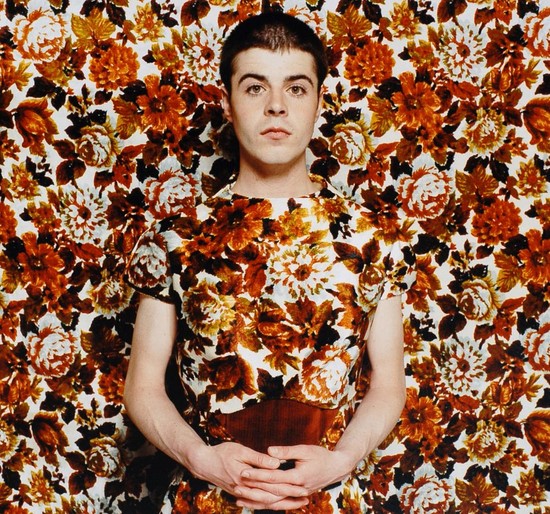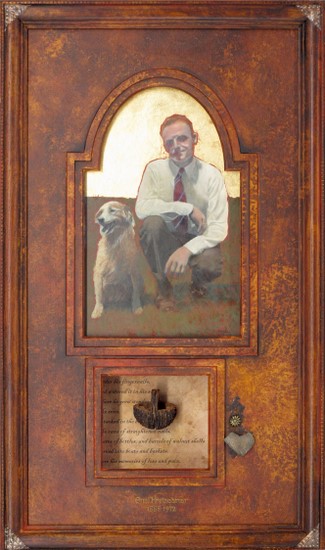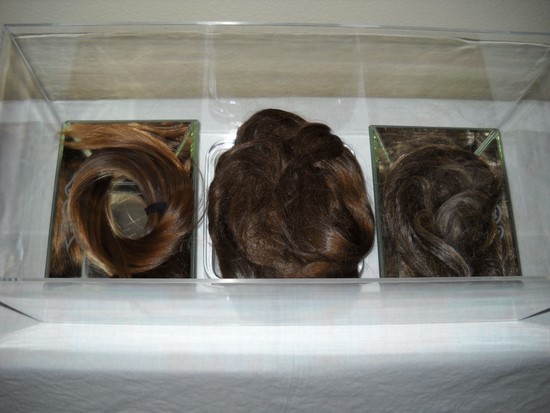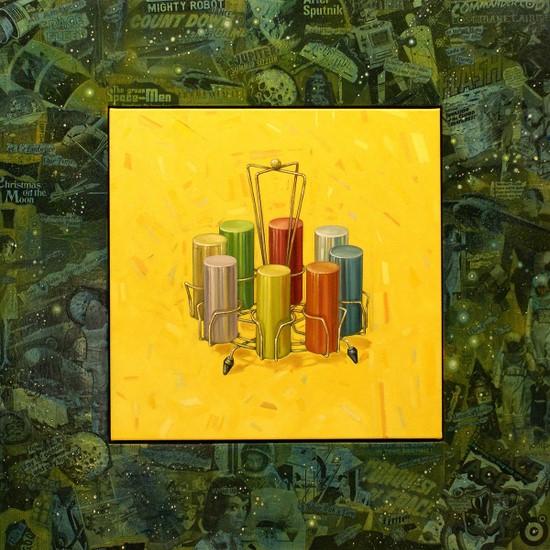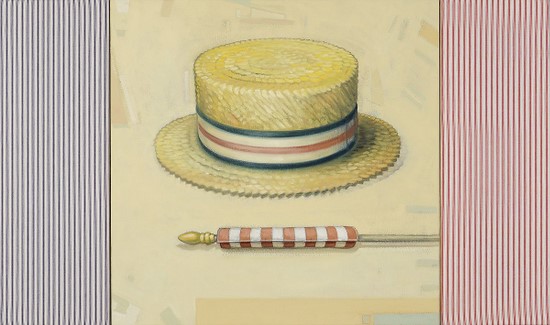Quad City Arts has hosted a variety of themed shows over the years - such as The Cat Show, The Dog Show, and The Artist in You - but the current Roots: Who's Your Momma? reveals an emotional intellectualism in many of our local artists. Running through October 1, the exhibit features 49 artworks by 29 regional artists, and in a novel move, the exhibit has been divided between two venues: Quad City Arts in Rock Island and the German American Heritage Center in Davenport.
The artists who truly tackled the theme of Roots generated some thought-provoking pieces that make the viewer contemplate different aspects of the concept of "home." While several works are too loosely connected to the theme, poignant and well executed art dominates. And the inclusion of artists' statements makes the show accessible to the casual viewer, connecting the work to the theme. (Full disclosure: I have a piece in the show and work occasionally at the Quad City Arts gallery.)
One great aspect of these open-call themed shows is that they shake out a lot of fresh talent; many artists who lack the consistent portfolio to apply for an individual or small-group exhibit are able to produce a viable piece for a show such as Roots. Tracy White, for example, is better known for his poetry but contributed two strong works of visual art to Roots - including a striking abstract and simplified lit-glass sculpture. (Unless otherwise noted, all the works discussed in this article are on display at Quad City Arts.)
Another exciting newcomer is Corbett Fogue, whose two sets of photographs are hopefully harbingers. Fogue's untitled series of four photographs has the same man as their subject, staring at the viewer with folded hands and a blank expression. In each photo, he is wearing a different, simply cut dress, and is posed against a background made from the same fabric.
This is an odd domestic camouflage, reflecting the situation of a person who is "different": His clothing (unusual for a man) blends in, yet his face and hands (which are normal) stand out. Fogue uses straightforward technique - neutral but clear lighting, rich but not bright colors, and a calm, centered composition. The depth of field is shallow, making viewers feel as though they are a conversational distance from the man in a cozy-sized room. The large format of the photographs and their unobtrusive framing enhance the effect, making viewers feel almost physically present with the subject.
Another standout is Mimzi Haut's St. Emil Reliquary. This mixed-media piece is contained in a shoe-box-sized wooden crate, featuring a painted portrait in the the top half, with the bottom half comprising a poem and a basket carved from a walnut. The title refers to the work as a reliquary, an ornate container that houses an object associated with a saint, with the walnut basket taking the place of the traditional artifact.
This work is beautiful not only in its appearance but in the subtle tone of Midwestern practicality meeting the ancient and magical. The loving detail applied to the box's exterior - including a heart-shaped rock mounted as a type of handle and Emil's name and life span painted in ornate, medieval-looking lettering - and the gold-leaf effect of the painting's background make this a captivating work. The modern, painterly style of the portrait and the uncle's contemporary pose and clothing - crouching down with a dog while wearing business-casual attire - contrast with the overall antique feeling of the container's finish. This work speaks to the surreal quality of our memories of lost loved ones - seemingly gone forever but somehow still present.
The found-object sculpture Multigenerational, by Mary Pat LaMair, stands out because of its conceptual nature. Reminiscent of Fluxus boxes or the work of Jeff Koons, it features a clear plastic box like those holding treasured objects in museums. In the box are three glass dishes with neat ponytails of hair atop them. On inspection, the three sets of hair are similar - reddish-brown and straight, medium texture - but seem progressively older when viewed left to right. Human hair removed from a head can carry connotations of beauty, vanity, rites of passage, or death. When placed on seemingly scientific or archival display, that ambiguity is compounded.
Upon reading the artist's statement, we learn that this sculpture began when LaMair found an unexplained plastic bag of her grandmother's hair. The other bundles came from LaMair herself and her mother. The similarity of the hair, from different generations of the same family, serves as a visual reminder of genetic similarity. But much of the intrigue of this piece lies in mystery: Why did LaMair's grandmother store her hair for years in a basement? The tangible nature and treatment of the real hair effectively explore both the show's theme and the true-story genesis of Multigenerational.
Reflecting shared American heritage is Mothership by John Paul Schafer. The center of the painting depicts a set of 1950s drinking cups displayed on a rack. Presented without context, these cups seem like illustrated geometric figures from a visual-math problem. On the perimeter of the painting, Schafer creates a "frame" of collaged Cold War- and space-race-era advertisements and periodicals - some serious and scientific in tone, others whimsical and childlike. Schafer's method of painting makes slick use of textures; viewed from afar, everything looks smooth and pristine, but closer up, there are slightly rough visible brush strokes and hidden layers of color.
Mothership works as a visual summary of mid-century American culture while remaining both cryptic (through the seemingly significant presentation of the cups) and fun (through the kitschy print media and bright colors). The piece conjures memories of contradictory feelings: about astounding scientific progress, mass media, and emerging consumerism; hopes for future innovation; and subtle worry.
Schafer also delivers with a painting on display at the German American Heritage Center. Campaign Stop is a mixed-media canvas the size and format of a state flag, and it's even divided into thirds, evoking the Iowa state flag. The left and right panels are striped cottony fabric, stretched as one would when preparing a canvas. The center panel contains an oil painting, depicting an old-fashioned straw campaign hat and a rolled-up, hand-sized American flag, with subtle geometric shapes and textural effects under glazes of paint in the background.
The color scheme of muted and warm reds, blues, and off-whites matches the Americana aesthetic often found in patriotic folk art and crafts. This painting suggests the "for the people" vibe that candidates often strive for during campaigns. This seems particularly relevant in Iowa, where every four years the official presidential-nominating process begins.
The show contains many other strong works. The Holy Communicator by Paul Algueseva III is a realistically rendered fired-clay sculpture that blends concepts of family, religion, and science in one fantastical portrait. His use of a bust of an aged woman brings to mind motherhood, with her fruit necklace referencing the Biblical forbidden fruit, and the monkeys clinging to her head recalling mankind's evolution.
Peter Xiao contributes a painting that reflects his identity as a China-born American through a touching single moment of watching the Philadelphia Symphony Orchestra perform on Chinese TV. Susan Mart's My Neighborhood provides a window into her childhood experience of walking to school in East Moline through an unusual format: 10 small canvases of close-up and abstracted scenes.
The premise of Roots inspired smart, intelligent, and varied mediations on heritage, culture, family and home, and provided a platform for many newer talents. The meaningful theme allowed local artists to show that their roots indeed run deep.
Roots: Who's Your Momma runs through October 1 at Quad City Arts (1715 Second Avenue in Rock Island) and the German American Heritage Center (712 West Second Street in Davenport). For more information, visit QuadCityArts.com.
Michelle Garrison is a mixed-media artist who teaches art and design at Geneseo Middle School and J.D. Darnell High School. She can be reached at michelle_m_garrison@hotmail.com.

